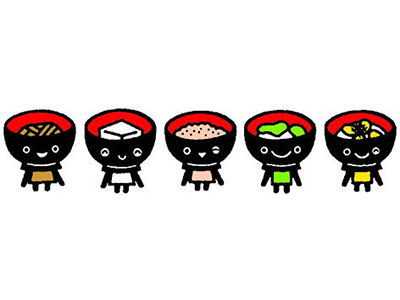Iwate prefecture is a treasure-trove of local cuisine that makes the most of the flavors of the regional, seasonal produce cultivated in its expansive natural surrounds.
From the 3 famous noodle dishes of Morioka to the rice cake culture in the south, cereal culture in the north and the seafood cuisine of the coastal regions, Iwate is unique for the wide variety of very different foods available.
Please visit Iwate and enjoy everything we have to offer.

A dish comprising of pieces of flour and water kneaded and rolled thin by hand before being torn apart, cooked in a soy sauce-based stew with other ingredients including chicken, burdock root, carrot and mushrooms. The name "hittsumi" is derived from a Japanese phrase meaning "to pull apart by hand" which is said "hittsumu" in the local dialect. Other regions refer to the dish by names such as "tottenage", "hatto" and "kiribatto". With its smooth flavor and warmth for both body and the heart, hittsumi is a local Iwate dish that will really hit the spot.

Wanko soba, coming from the southern region of the prefecture, is said to be the original soba (buckwheat noodles). This legendary local dish came from the hospitality of locals who wanted diners to enjoy as much of the freshly boiled, delicious noodles as they could eat. When a plate is bare, it is quickly refilled and diners end up with a pile of plates to show just how much they've eaten. While enjoying the noodles with a variety of condiments, when you've had enough you must immediately put a lid on your plate to show you've finished your meal. About 10-15 plates of wanko soba equals one serve of regular soba.

Originating in PyongYang, chilled noodles (reimen) appeared in Morioka in 1954 when someone from the Korean peninsula made the noodles in memory of his homeland. Morioka chilled noodles are known for their slippery quality that comes from a mixture of flour and starch, as well as their chewy texture. Also unique is their rich soup made on a cow hide base. For those who don't like spice or who wish to control the spiciness of their meal themselves, we recommed ordering a "betsukara" version of the dish where the kimchi comes on the side.

Jaja noodles combine the flavor of special miso marinated beef with vegetables such as cucumber and shallots and warm, flat flour-based noodles. The meal is best enjoyed by adding condiments to your liking such as vinegar or chili oil and grated ginger or garlic to create a unique flavor. To finish the meal, add a raw egg to the broth and meat to make what is called "chitan soup". Some fans say that without this ending, it doesn't feel like they have eaten ja ja noodles.

This dish is made of udon noodles fried with cabbage and other seasonal produce. The noodles are fried in olive oil with a special salted sauce and black pepper for a spicy bite, and topped with locally grown meat. Sprinkled with aromatic sesame seeds, the meal is known for its light and healthy salted flavor.

A croquette made with Kitakami taro for a unique texture. Accented with Iwate wagyu beef or Kitakami Shirayuri branded pork and Iwate's largest export, asparagus, the croquettes are known for being a sticky mouthful that people get hooked on.

Up until the 1940s in Muranomura, Ichinoseki, households raised their own chickens. For celebrations or other events they would cook a chicken and be able to enjoy the 20g of precious stomach meat contained in each bird. This traditional regional dish has had a resurgence over 40 years later and is known as "Ichinoseki fried chicken".

In the south of Iwate prefecture, mochi (pounded rice cakes) has been prepared and served at ceremonial occasions and other agricultural or seasonal events from long ago and is still a staple in the lives of the people today. With many different types of mochi dishes available including: mochi with sweet bean paste, boiled with vegetables, with mashed green soybeans, with sesame, with shrimp or with chili in a dish called "fusube"; it is said there are over 300 ways to eat mochi. In the south of the prefecture there are many restaurants offering mochi cuisine which can be enjoyed all year round.

Cultivating oysters from long ago, the area along the shore from Miyako city to Rikuzentakata city in Iwate is full of oyster aquaculture farms. Cultivated in clean sea water, Iwate's oysters are known for their size, and "oyster huts" offering steamed oysters are in full swing from autumn to spring.

This local dish of Yamagata in Kuji City is made of flour, salt and water kneaded into balls about the size of a thumb that are then filled with walnuts and brown sugar. The dumpling carry a prayer for living faithfully, safely and good health and mamebu is often made for festivals, new year's or other celebrations.

Mixed grains are full of minerals and fibre, and in the north of Iwate, where it is difficult to grow rice, a large variety of millet and buckwheat were grown, resulting in many recipes for mixed grains. One famous dish is dumplings made of sorghum powder in a red bean soup known as "hecchokodango" (dumpling soup). It is said the name comes from a Japanese word for belly button (hecchoko or oheso) which the dumplings look like due to sunken hole made in their middles. The dish is still eaten as a traditional meal in the north of the prefecture.
